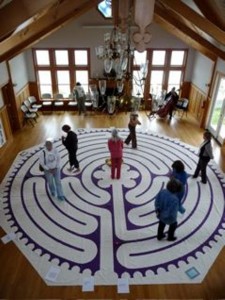
The Labyrinth in Emmanuel Episcopal Parish Hall
Contributed by Nancy Ayer
Emmanuel Parish in Eastsound invites the public to participate in its Labyrinth on the Lawn on Sunday, June 7, from 9-Noon at the Emmanuel Parish Green in Eastsound.
What is a Labyrinth?
“A labyrinth is a practice for personal growth, a tool for community building, and an agent for peace”. Rev. Dr. Lauren Artress
The Rev. Dr. Lauren Artress of Grace Cathedral in San Francisco is the pioneer and leading force behind the modern day, worldwide labyrinth movement. She believes that “the missing ingredient in today’s Western culture is the search for a meaningful, symbolic life.” The labyrinth plays a key role in this quest.
This walking path of prayer and meditation represents an outward experience of our inward journey to our center. The labyrinth is an ancient symbol for reflection and growth. Its circular, spiral-like shape stands for unity and wholeness. It is a metaphor for walking the path of life. “So when people walk into the labyrinth”, says Artress, “they begin to see their whole life”.
The labyrinth dates back 5000 years. The oldest labyrinth in existence is in Chartres Cathedral outside of Paris. This labyrinth was built in 1201 and is still walked by pilgrims today, much the same as it was centuries ago. People of all ages, backgrounds, denominations and cultures walk a labyrinth.
Today, labyrinths can be found in places as diverse as churches and synagogues, colleges, community parks, corporations, hospitals, clinics, nursing homes, prisons, spas, gardens, theaters, woods and forest clearings.
A labyrinth is not a maze. A labyrinth is a single, circuitous path into the center. The same path exits the center and returns to the beginning. Thus the beginning becomes the exit. There are no tricks or dead ends on a labyrinth. The object while walking a labyrinth is not to have to think, rather it is about letting go of all thought. This brings you into the present moment. Dropping the left -brain- thinking mode, moves one into the right brain of feeling; the place where intuition, and creativity can be accessed.
There are many reasons why people walk a labyrinth. A labyrinth is walked to gain insight for artistic inspiration and problem solving. Labyrinths are used for prayer, meditation, personal transformation, grief work, therapy, recovery, and healing. Milestones and special events in people’s lives are also celebrated on the labyrinth.
The labyrinth always meets you where you are. There is never any right or wrong way to walk it.






